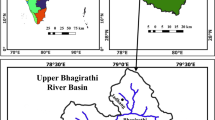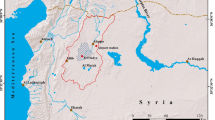Abstract
Base flow separation to identify groundwater contribution in river flow is important, and is one of the basic studies in hydrological science. Base flow separation approaches are important for determination of ∅ index to calculate rainfall excess and rainfall losses in a watershed, unit hydrograph, and also estimating groundwater recharge. In this study, 15 base flow separation methods were used in “Chamanjir” outlet of Khorramabad watershed in Iran, and the results were compared with Recession Curve method as the base method. The results showed that most of these methods were significantly different at 95% confidence level. The results of comparing different methods’ efficiency also revealed that sliding interval method, considered 91.6% of the river discharge as base flow, which was the highest value among all methods. Furthermore, this method with the lowest mean square error and the lowest absolute error was selected as the best method for Khorramabad watershed. Comparison of different methods’ results showed that there are differences between the base flow separations in different ways. Eckhardet algorithm or two parameters algorithm with α = 0.925 due to considering the hydrological characteristics of the stream and watershed, and for its lower error, can be used as the best method of base flow separation in next studies in the study area. Moreover, based on the results, the highest fraction of runoff is related to the base flow in this watershed. The results of this study can be appropriate to determine the fraction of the groundwater discharged to the river flow, and also can be used for the drought studies.









Similar content being viewed by others
References
Arfania R, Samani N (2005) Draw the curve of river hydrograph separation hydrograph separation in Zayanderod karst basin. Sci J Tarbiat Moallem Univ 5:585–600 (In Persian)
Barnes BS (1939) The structure of base flow recession curves. Trans Am Geophys Union 20:721–725
Chapman TG (1991) Comment on “Evaluation of automated techniques for base flow and recession analyses” by R. J. Nathan and T. A. McMahon. Water Resour Res 27:1783–1784
Chapman T (1999) A comparison of algorithms for streamflow recession and base flow separation. Hydrol Process 3:701–714
Chow VT, Maidment DR, Mays LW (1988) Applied hydrology. McGraw-Hill Publishing Company, New York, pp 572
Coutagne A (1948) Etude ge´ne´rale des variations de de ´bits en fonction des facteurs qui les conditionnent, 2e `me partie: Les variations de de´bit en pe´riode non influence ´e par les pre´cipita-tions, La Houille Blanche, Septembre–Octobre, pp 416–436
Eckhardt K (2008) A comparison of base flow indices, which were calculated with seven different base flow separation methods. J Hydrol 352:168–173
Gardner WP, Susong DD, Solomon DK, Heasler H (2010) Snowmelt hydrograph interpretation: revealing watershed scale hydrologic characteristics of the Yellowstone volcanic plateau. J Hydrol 383:209–222
Gregore M (2010) User manual ‘BFI + 3.0’. Department of Hydrogeology, Faculty of Natural Science, Comenius University, Bratislava, Slovakia. https://hydrooffice.org/Files/UM%20BFI.pdf
Haghiabi AH, Basirzadeh H, Mastorakis NE (2009) Optimizing management of the Karkheh Reservoir in Iran under uncertainty. In: Proceedings of the 3rd international conference on energy and development—environment—Biomedicine, Greece, EDEB’09
Hall FR (1968) Base flow recession, a review. Water Resour Res 4:973–983
Institute of Hydrology (1980) Low flow studies research report. Institute of Hydrology, Wallingford
Kubota J, Sivapalan M (1995) Towards a catchment-scale model of subsurface runoff generation based on synthesis of small scale process based modeling and field studies. Hydrol Process 9:541–554
Li Q, Zing Z, Danielescu S, Li S, Jiang Y, Meng FR (2014) Data requirements for using combined conductivity mass balance and recursive digital filter method to estimate groundwater recharge in a small watershed New Brunswick. Canada J Hydrol 511:658–664
Lim KJ, Engel BA, Tang Z, Choi J, Kim KS, Muthukrishnan S, Tripathy D (2005) Automated web GIS based hydrograph analysis tool, WHAT1, J Am Water Resourc Assoc 41(6):1407–1416
Linsley RK, Kohler MA, Paulhus JLH (1975) Hydrology for engineers, seconded. McGraw Hill, Inc, New York, pp 482
Lodouche A, Probst D, Viville S, Baque M, Loubet J, Probst L, Bariac T (2001) Hydrograph separation using isotopic, chemical and hydrological approaches (Strengbach catchment, France). J Hydrol 242:255–274
Lvovich MI (1972) Hydrologic budget of continents and estimate of balance of global fresh water resources. In: Soviet hydrology, vol 4, pp 349–360
Lyne VD, Hollick M (1979) Stochastic time-variable rainfall runoff modeling. In: Hydrology and water resources symposium institution of engineers, Perth, Australia, pp 89–92
Mahdavi M (2002) Applied hydrology, vol 2. Tehran University Press, Tehran, pp 440 (In Persian)
Mc Cuen RH (1998) Hydrologic analysis and design. 2nd edn. Prentice-Halling, Upper Saddle River
Mosavipour SF, Syed tabai S (2011) Single channel optimal cancellation of industrial acoustic noise. M.Sc Thesis. Shahed University, Iran (In Persian)
Nathan RJ, McMahon TA (1990) Evaluation of automated techniques for base flow and recession analyses. Water Resour Res 26:1465–1473
Santhi C, Allen MP, Muttian RS, Arnold JG, Tuppad P (2008) Regional estimation of base flow for the conterminous United States by hydrologic landscape regions. J Hydrol 351:139–153
Shahriari Nia E, Asadollahfardi G, Heidarzadeh N (2016) Study of the environmentalflow of rivers, a case study, Kashkan River, Iran. J Water Supply Res Technol AQUA 65(2):181–194
Szilagyi J (2004) Heuristic continuous base flow separation. J Hydrol Eng ASCE 9(4):311–318
Uhlenbrook S (2006) Catchment hydrology—a science in which all processes are preferential. Hydrol Process HPToday 20(16):3581–3585. https://doi.org/10.1002/hyp.6564
Wittenberg H (1994) Nonlinear analysis of flow recession curves. IAHS Publ 221:61–67
Wittenberg H (1999) Base flow recession and recharge as nonlinear storage processes. Hydrol Process 13:715–726 (Special Issue Process Inter-actions in the Environment)
Author information
Authors and Affiliations
Corresponding author
Rights and permissions
About this article
Cite this article
Mohammadlou, M., Zeinivand, H. Comparison of different base flow separation methods in a semiarid watershed (case study: Khorramabad watershed, Iran). Sustain. Water Resour. Manag. 5, 1155–1163 (2019). https://doi.org/10.1007/s40899-018-0292-y
Received:
Accepted:
Published:
Issue Date:
DOI: https://doi.org/10.1007/s40899-018-0292-y




